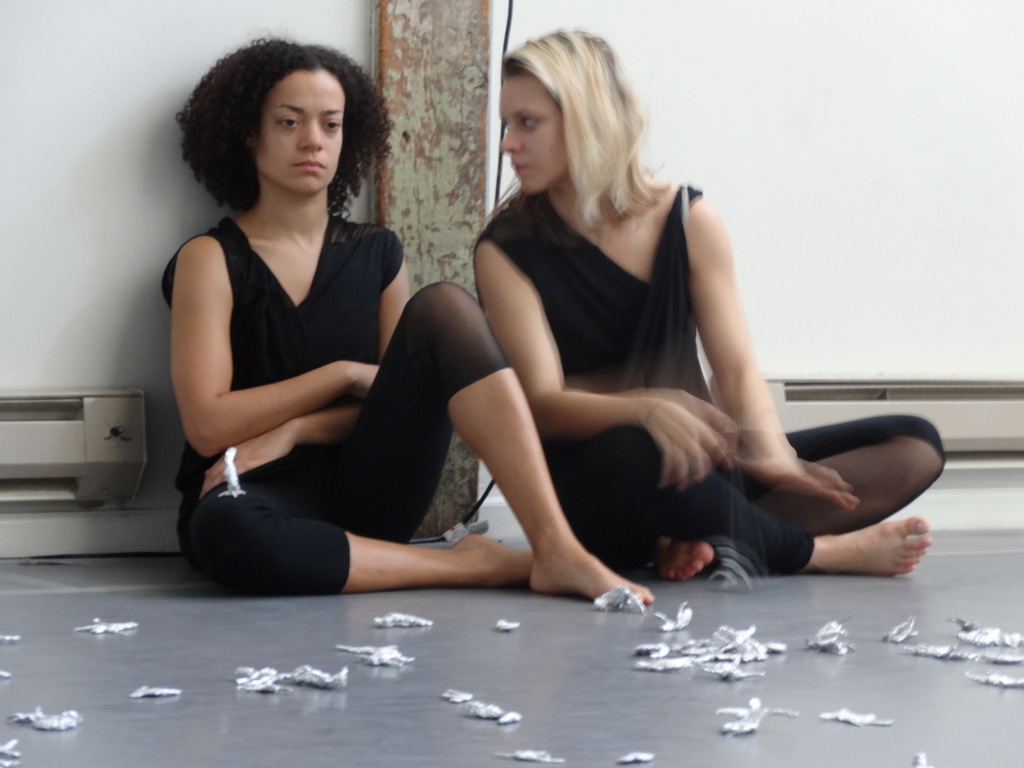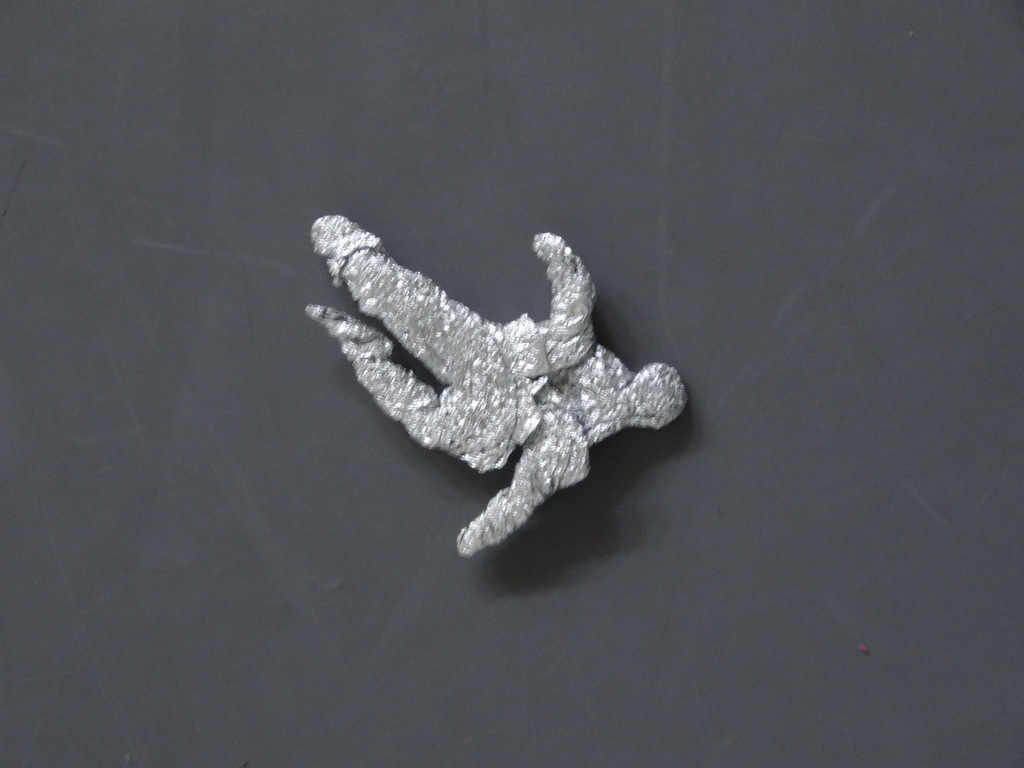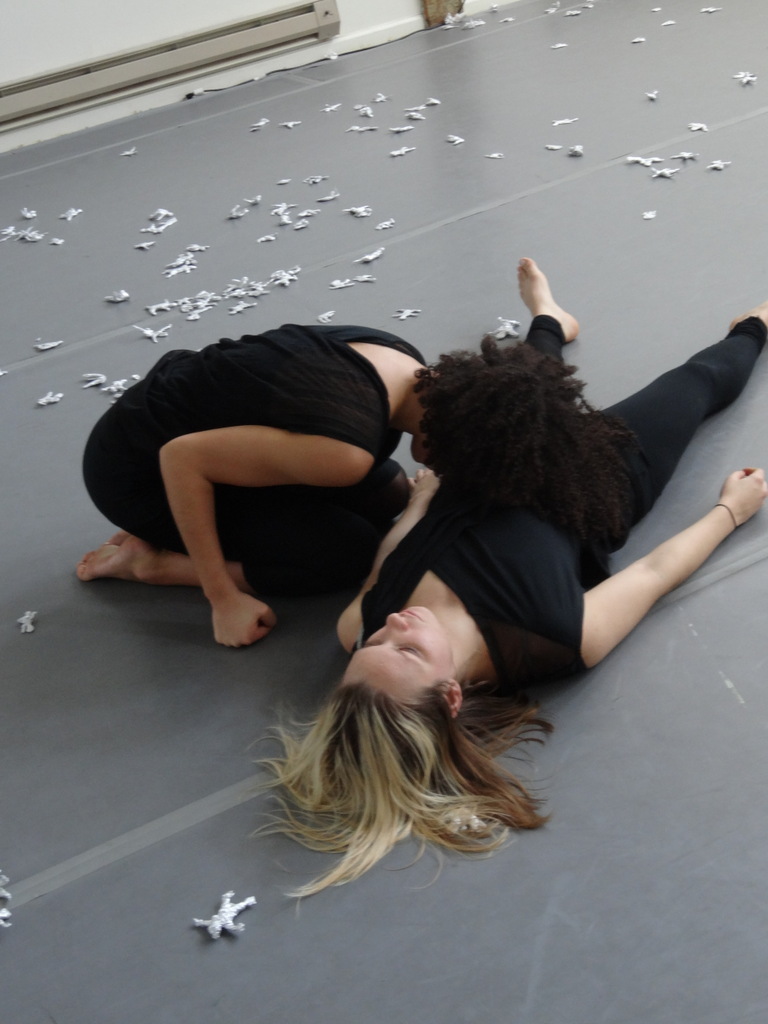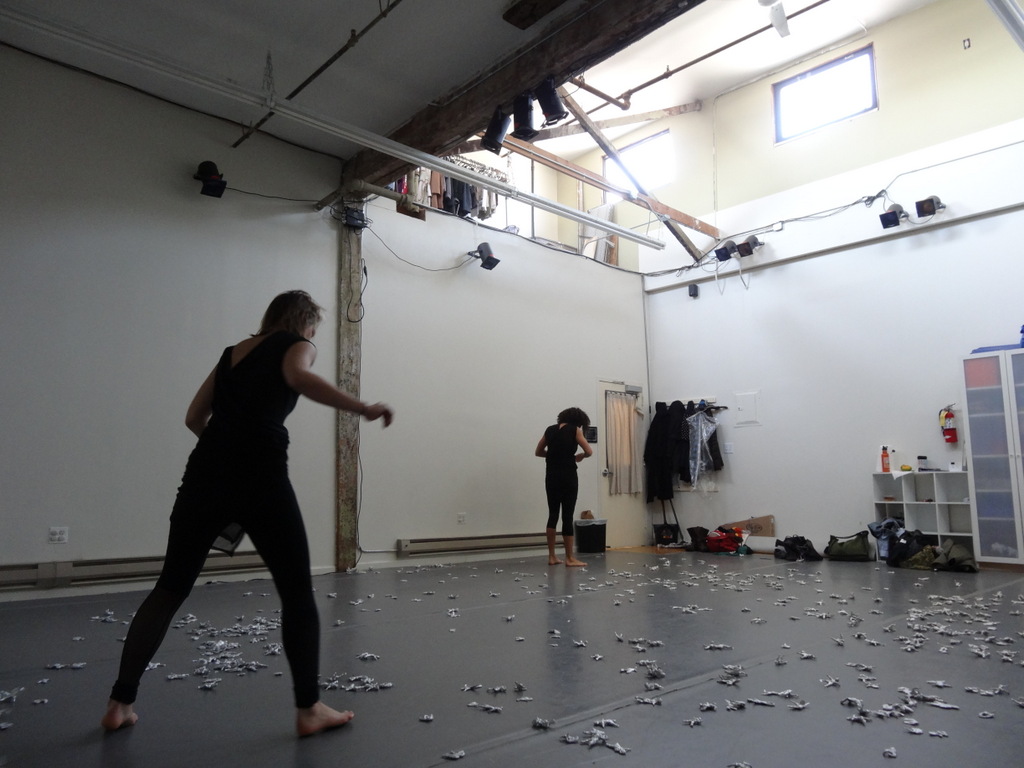
“What’s the ugliest way you can stuff your pants with the dolls?” Shannon asks.
It’s 1 pm; Katie and Calia are halfway through their rehearsal. They have spent two hours working through kinks, practicing specific sequences and exploring possible costume malfunctions. The duo is about to embark on their first full run. Opening night is one day shy of two weeks away.
down here is a new evening length work choreographed by Cora Dance’s Shannon Hummel in collaboration with dancers, Katie Dean and Calia Marshall. The show is Shannon’s first evening length work in five years.
There is no scenery. A fancy light display does not adorn the performance. The stage has no exits and entrances. Shannon calls lights up, and Katie and Calia are poised.
A mystic music plays in the background. No dialogue is ever scripted or exchanged, but communication between the two players is constant.
Amidst the mystique, an unusual foil-like object falls from the sky; the conflict is set into motion. Calia transforms the scrap into a symbolic doll, and the set fades to blackout.
When the lights come up, the stage has been littered with hundreds of these silver dolls. Each dancer embarks on their own exploration. Katie is content to play quietly against the wall where she sits. Calia imagines imaginary playmates, offering them to an uninterested Katie. Without Katie’s attention, Calia’s demonstration gets bigger and bigger, finally taunting Katie into a reaction. Katie swings into full on aggression, wrapping the silver dolls around her fingers and entwining them in her hair. She selfishly stuffs handfuls into her pants, clearly upsetting Calia. When they attempt to communicate, a constant misunderstanding persists throughout the show.
At a certain point Katie “just stops participating,” Shannon explains. She lies motionless on the floor, as Calia attempts to reengage her partner. When nothing proves effective, Calia aggressively begins sweeping every tin doll off of the stage with her hands. When she is nearly finished, the audience finds Calia in a sentimental moment as she tucks the last remaining doll into her costume, very near her heart. Katie is finally awakened by Calia, and they find a tender moment of peace. But this is not the finale, and the conflict that began with the foil beings still lingers.
Katie and Calia struggle through more miscommunications and adversities, finding rare moments to meet in the middle. As the show continues on, these meetings grow increasingly scarce. When the show finally closes, the resolve between the two is a subtle surrender to peace with hints of overcoming their misunderstandings.
down here is just as much a theater show as it is a dance performance. Without a script, the characters are forced to find alternate ways of presenting their stories without speaking. The dynamic this conundrum presents frustrates both performers into a constant state of struggling to be understood, which is almost always misinterpreted by the other. “We just don’t speak the same language,” Katie says.
The story is ultimately about relationships. “Two characters plummet through the world together, understanding and misunderstanding each other, repelling and propelling, doing good and harm,” writes Katie. The performance reflects Katie and Calia as friends, sisters, lovers, and every other relationship encountered in life. It is messy, and the resolution is neither concrete nor simple.
“In any authentic relationship, there’s grief,” Shannon explains. “There is so much sadness in the struggle for unattainable things. I don’t fight [those] landmines.” The dance includes a lot of things that some might not think is a dance. “I hope [the audience] can find a moment in it that they can personalize in some way.”
The context is really important to Shannon. “How much do I give in this moment, and how much do I let resonate. In a relationship or any sort of situation where there is any sort of vulnerability, you have to strike a balance [between] individuality but also unity. Beautiful movement is just one piece of the puzzle.”
Watching Katie and Calia create common truths strung together becomes “a conversation about how [life] feels,” Shannon says. “I don’t believe in ‘ta-dah’ moments because there is always the ‘after the ta-dah’.” She is creating a dance that not only identifies humanity, but also suggests a universal relationship between two people.

Shannon, who also directed theater in college, relies on her instincts for choreography by “trying to find that authentic moment and feel how it lives. I don’t know why I know, but I just know.” A sense of honesty all the way through is most valuable for her. “We’re on the right path when I can sit down and watch it for the first time – again. I forget what happens next.”
The story is a constant work in progress; there are always going to be “shifts and changes,” Shannon says. The first twelve minutes have been ripped apart and put back together multiple times. The piece is highly choreographed and always structured to make space for the dancers to create. “That’s when it belongs to them. The choices they make will determine what the piece will be about.”
For Calia, who started studying dance in college, she is “drawn to dances that want to have their own internal world.” She explained that the initial stages of choreography for this piece began a little over two years ago with improvisation exercises and gestures connected with the seven deadly sins. “This process is more about the narrative, what’s inside of it.” For her, keeping the intention set allows room for the narrative to always be open with Katie. While the specifics may remain uncertain, the performance speaks to the individual. Audience members will find relevance based on their own struggles and complications from life.
Shannon is “fixated on” circles; they are thematic in her work, often suggesting time and distance. “Circles expand my notion of how [Katie and Calia] travel in time.” In rehearsal, the trio played with speed of circles traveled – running, walking, marching around and around. Sometimes Calia and Katie are dragging each other. Sometimes one follows the other. And other times they are simply traveling in the same orbit together, but in opposite directions. Shannon explains this as “a finite barrier, a robotic need to get through [life]. There are no exits.” Indeed, there are no exits in life.
Circles are “unavoidable in the things I make. They have no clean starting and ending point. There’s a reason they have to stop.” Shannon compares this piece to Robert Frost’s famous poem, “The Road Less Traveled.” No matter which road we take, we are always taking the path less traveled because each of us is unique. “I’m ending up in the same old/new place I’ve always/never been,” she says.
Shannon’s dances are often more about movement than dance technique. She starts with something relevant to the individual. “Movement belongs to everyone. I meet people where they are; I like to work with what I’m given. I’m working with different things when I work with people with no movement background.”
“Words are always really hard for me, so dance is always really hard for me. Choreography is not easy, but so worthwhile,” she says. “It feeds this very deep part of me.”
Movement versus the intent of movement creates “a sense of the palette” in relationship to the constant changing of the dance. Katie says, “I’m trying to learn something that keeps changing and I have to relate to all of it as it shifts.”

Shannon’s talent for storytelling in down here is apparent in her choreography. She was raised by her grandparents. “I come from really old story-telling people. If they didn’t have to say something, they didn’t. There was always more to the story than the story told. My place was to shut up and listen,” she says. “I’ve been riveted by how people tell stories since I was born.”
For Shannon, putting together this piece has been gratifying, but also challenging. Delays and personal challenges, “so many insurmountable things” have kept them out of the studio over the past couple of years. But they still managed to meet. To her, it is “the time to be with these two friends, performers and other women to work on something I’m feeling.”
Shannon, Katie and Calia have incorporated their own experiences into the work. In down here, Katie and Calia have different viewpoints, often making them feel isolated. In their attempts to connect, they often misconnect, leaving them unconnected. Every audience member can relate to their heartache. For each of us, that personal experience is different, but universal. “Whatever it reminds you of is what it is supposed to remind you of,” Katie says.









